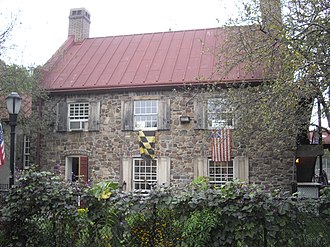Old Stone House (Brooklyn, New York)
 |
|
| Established | 1934 |
|---|---|
| Location | 336 3rd Street (between 4th and 5th Ave) Brooklyn, New York City |
| Website | |
|
The Old Stone House of Brooklyn
|
|
 |
|
| Coordinates | Coordinates: 40°40′23″N 73°59′05″W / 40.672958°N 73.984625°W |
| Built | 1935 |
| Architectural style | Colonial Revival |
| NRHP Reference # | 12000797 |
| Added to NRHP | September 19, 2012 |
http://www.theoldstonehouse.org
The Old Stone House is a 1933 reconstruction, using some original materials, of the Vechte–Cortelyou House, which was destroyed in 1897. The original house was an important part of the 1776 Battle of Long Island during the American Revolutionary War; its reconstruction is on Third Street between Fourth and Fifth Avenues, in the J. J. Byrne Playground of Washington Park, in the Park Slope neighborhood of Brooklyn, New York City. Gowanus Creek once ran nearby, but today the southeastern branch of the Gowanus Canal ends 1300 feet (400 m) west of the house, near Third Avenue between Third and Sixth Streets.
At one time, the Old Stone House was the clubhouse of the Brooklyn Superbas, who later became the Brooklyn Dodgers. The house was listed on the National Register of Historic Places in 2012.
The current Old Stone House is a replica, using some unearthed original materials, of a Dutch stone farmhouse originally built adjacent to the current site by the Dutch immigrant Claes Arentson Vechte in 1699. It is also known as the Vechte–Cortelyou House. The Vechte family farmed the lands around the house, harvested oysters in Gowanus Creek and ferried their produce down the creek to Gowanus Bay and then to lower Manhattan. The house was rented in 1766 by Isaac Cortelyou, but later returned to Vechte. It was then inherited in 1779 by Nicholas Cowenhoven, who sold it in 1790 to Jacques Cortelyou. Cortelyou's son, Peter late received it as a wedding gift from his father.
On August 27, 1776, the house was an important location in the Battle of Long Island during the American Revolutionary War - the first major engagement of the Continental Army after the Declaration of Independence, and the largest battle of the entire war.
...
Wikipedia



